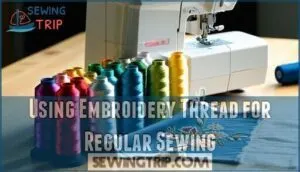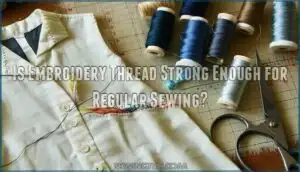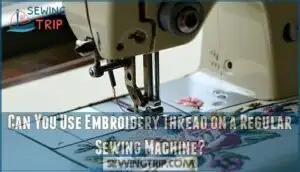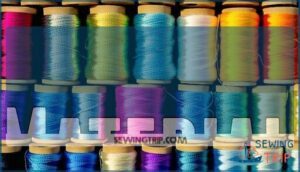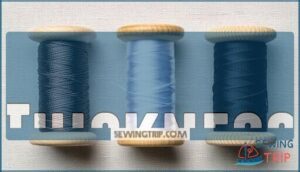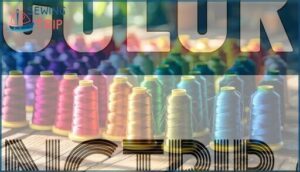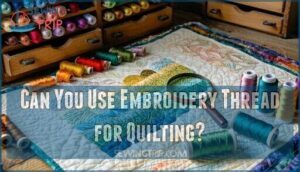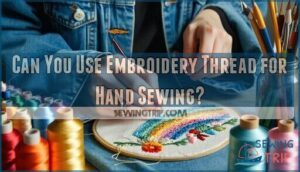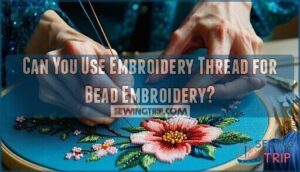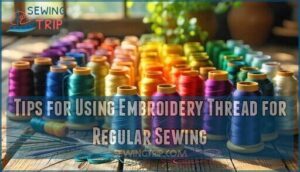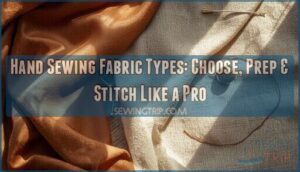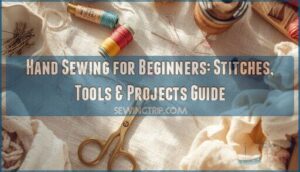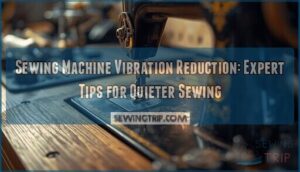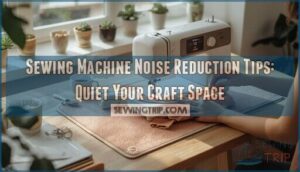This site is supported by our readers. We may earn a commission, at no cost to you, if you purchase through links.
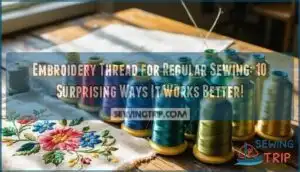 You can use embroidery thread for regular sewing, but it’s not always the best fit.
You can use embroidery thread for regular sewing, but it’s not always the best fit.
Embroidery thread, often made from rayon or polyester, is thinner, shinier, and more delicate than the sturdy cotton or polyester used for regular sewing.
This means it’s great for decorative stitches or lightweight fabrics, but it might not hold up for heavy-duty seams or thick fabrics.
Be mindful of its stretchiness and adjust tension on your sewing machine to prevent snags or breakage.
While it’s not a universal solution, it can add a touch of brilliance to your projects.
Curious about choosing the right type? Keep reading!
Table Of Contents
- Key Takeaways
- Using Embroidery Thread for Regular Sewing
- Is Embroidery Thread Strong Enough for Regular Sewing?
- Can You Use Embroidery Thread on a Regular Sewing Machine?
- Embroidery Thread Vs. Regular Sewing Thread
- Choosing The Right Embroidery Thread for Regular Sewing
- Can You Use Embroidery Thread for Serging?
- Can You Use Embroidery Thread for Quilting?
- Can You Use Embroidery Thread for Hand Sewing?
- Can You Use Embroidery Thread for Bead Embroidery?
- Tips for Using Embroidery Thread for Regular Sewing
- Frequently Asked Questions (FAQs)
- Conclusion
Key Takeaways
- Test your machine’s tension and use embroidery or topstitching needles to prevent thread fraying or breakage.
- Use embroidery thread for decorative stitches and accents, not for load-bearing seams or high-stress areas.
- Polyester embroidery thread offers better strength and durability compared to rayon for regular sewing tasks.
- Opt for longer stitches and apply thread conditioners to reduce tangles and ensure smoother sewing.
Using Embroidery Thread for Regular Sewing
Experimenting with embroidery thread for regular sewing opens up exciting possibilities for your projects.
Unlock vibrant creativity by sewing with embroidery thread—perfect for adding decorative flair and colorful accents to your projects.
While not designed specifically for construction, embroidery thread can add decorative flair with its vibrant colors and lustrous finish.
Consider thread durability and fabric compatibility before starting—embroidery thread is thicker than regular sewing thread, requiring tension adjustments on your machine.
For best stitch appearance, match project suitability with thread type: rayon offers shine while polyester provides strength.
Remember that embroidery thread creates more lint than regular sewing thread, so clean your machine more frequently.
It’s perfect for accent stitches but less ideal for structural seams.
Is Embroidery Thread Strong Enough for Regular Sewing?
Now that you know the basics, you’re probably wondering about strength.
The truth is, embroidery thread isn’t as strong as regular sewing thread for construction. It’s designed for decoration, not structural seams.
Consider these key facts about embroidery thread strength:
- Seam Durability – Lower than regular thread for high-stress areas
- Thread Composition – Material matters; polyester versions offer better strength
- Fabric Compatibility – Works better on stable, non-stretchy fabrics
- Project Longevity – Less durable for items requiring frequent washing
- Stitch Appearance – Trades strength for decorative appeal and shine
For long-lasting garments, stick with regular sewing thread for construction seams.
Can You Use Embroidery Thread on a Regular Sewing Machine?
While embroidery thread isn’t ideal for structural seams, you can absolutely use it on your regular sewing machine.
Embroidery thread adds vibrant flair to your sewing projects—perfect for decorative stitches, but not for high-stress seams.
For best Machine Compatibility, you’ll need to make some Tension Adjustments and careful Needle Selection. Choose needles marked "embroidery" or "topstitching" with larger eyes to prevent fraying.
Slow your sewing speed and adjust your tension when working with embroidery thread. It works beautifully for decorative stitches, quilting, and topstitching—just not for seams that need strength.
For proper Thread Management, thread the machine carefully according to your manual to maintain good Stitch Quality throughout your project.
Embroidery Thread Vs. Regular Sewing Thread
The key differences between embroidery thread and regular sewing thread lie in their fundamental properties.
Embroidery thread offers higher sheen while sewing thread provides greater durability for construction.
| Characteristic | Embroidery Thread | Regular Sewing Thread |
|---|---|---|
| Thread Composition | Rayon, polyester | Cotton, polyester blends |
| Strength Comparison | Less strong, decorative | Stronger for seams |
| Stitch Appearance | Shiny, prominent | Matte, blends in |
| Cost Analysis | More expensive | More affordable |
| Best Applications | Decorative stitching | Structural seams |
While embroidery thread creates eye-catching designs, sewing thread handles the heavy lifting of garment construction.
Choose based on your project’s needs rather than using them interchangeably.
Choosing The Right Embroidery Thread for Regular Sewing
You’ll need to match your embroidery thread’s material, thickness, and color to your specific sewing project for best results.
Polyester or cotton embroidery threads work better for regular sewing tasks since they’re stronger than rayon varieties that are mainly for decoration.
Material
For regular sewing, you have several options regarding embroidery thread materials.
Polyester thread offers superior Fiber Strength and durability, making it ideal for items that need frequent washing.
Cotton thread provides a natural feel with less Thread Sheen, perfect for quilting projects.
Rayon delivers high shine but at a higher Material Cost.
Each thread material type has different Fabric Compatibility – polyester works on most fabrics, while silk embroidery thread suits delicate materials.
The Color Variety available in embroidery thread materials far exceeds regular sewing thread options.
You can find polyester thread options online.
Thickness
After choosing your thread material, you’ll want to think about thickness – a critical factor that affects your sewing success. Thread weight numbers work opposite to what you might expect: the higher the number, the thinner the thread.
For regular sewing with embroidery thread, understand these basics:
- 40wt – standard for most projects
- 60wt – finer thread for delicate details and lightweight fabrics
- 30wt – thicker for decorative topstitching
Your fabric choice directly impacts which thread thickness works best. Heavier fabrics need stronger, thicker threads, while delicate fabrics pair better with finer options. Understanding thread weight options is vital for achieving the desired effect. Always match your needle size to your thread thickness – larger needles for thicker threads to prevent fraying and breaking.
Color
After considering thread thickness, let’s look at the rainbow of possibilities that color brings to your sewing projects. One standout feature of embroidery thread is its vibrant color range—far more extensive than regular sewing thread.
When selecting thread colors for regular sewing projects, remember:
- Color fastness matters—choose polyester threads for items that will be washed frequently
- Check dye lots when buying multiple spools for consistent color matching
- Thread sheen varies between materials—rayon offers more lustrous colors than cotton
- Colorful embroidery thread can create stunning decorative topstitching that regular thread can’t match
- Consider how thread luster will appear against different fabric textures and colors
Can You Use Embroidery Thread for Serging?
The colorful world of serging opens up when you experiment with embroidery thread in your overlocker. Yes, you can use embroidery thread for serging, but with some important considerations.
The following table outlines the best uses and limitations for different types of embroidery threads:
| Thread Type | Best Serging Use | Limitations | Tips |
|---|---|---|---|
| Rayon Embroidery | Decorative edges | Less durable | Lower tension |
| Polyester Embroidery | Rolled hems | May break at high speeds | Practice first |
| Metallic | Accent stitching | Requires special handling | Slow down machine |
| Variegated | Color blending | Not for construction seams | Use for details only |
While embroidery thread creates beautiful decorative serging, it’s not as strong as regular serger thread. For best results, adjust your tension settings and test on scrap fabric first. This is crucial because embroidery thread can be more delicate, and using it correctly requires some special handling to achieve the desired outcome.
Can You Use Embroidery Thread for Quilting?
Quilters who experiment with Thread Weight discover that embroidery thread brings stunning visual impact to their projects.
You can absolutely use embroidery thread for quilting with excellent results.
Here are 5 embroidery thread quilting facts:
- Rayon offers high sheen for lightweight fabrics
- Polyester resists Color Bleeding better than rayon
- Thread Conditioners prevent tangling during stitching
- Quilting Needles with larger eyes accommodate thicker threads
- Design Impact is substantially enhanced compared to regular sewing thread
For machine quilting, polyester embroidery thread provides durability while maintaining visual appeal.
For hand quilting, embroidery floss (separated into one or two strands) works wonderfully with traditional quilting stitches, offering a unique visual appeal.
Can You Use Embroidery Thread for Hand Sewing?
Many crafters wonder about using embroidery thread for hand sewing. While it’s not as strong as regular sewing thread, embroidery thread can add beautiful decorative elements to your handstitching projects.
Here’s what you need to know:
- Embroidery floss works best for decorative stitches rather than structural seams
- Hard-wearing options like stranded cotton handle wear and tear better
- Thread strength needs vary – choose thicker thread for durable projects
- Fabric compatibility matters – lighter fabrics need finer thread
- For increased stitch visibility, embroidery thread’s thickness offers excellent definition
When using embroidery thread for decorative handwork, remember it shines for embellishments but isn’t ideal for high-strain areas. It’s worth pointing out that embroidery thread has a looser twist.
Can You Use Embroidery Thread for Bead Embroidery?
If you’re exploring bead embroidery, using embroidery thread or floss adds both beauty and function.
Choose thread strength based on your project types—polyester offers durability, while cotton works for light use.
Match thread color to your beads, especially for transparent ones, to keep your design seamless.
Bead size matters too; finer threads fit smaller beads better.
Employ precise stitch techniques, ensuring multiple thread passes to secure beads.
With the right embroidery thread sewing approach, your beading can really shine!
Tips for Using Embroidery Thread for Regular Sewing
Sewing with embroidery thread offers stunning results if done right.
Here are five practical tips:
- Needle Selection: Use an embroidery or topstitching needle with a larger eye to prevent fraying.
- Tension Adjustment: Lower the machine’s tension slightly for smoother stitches.
- Stitch Length: Opt for a longer stitch to reduce thread breakage.
- Thread Conditioner: Apply to minimize tangles.
- Fabric Choice: Match thread weight to fabric type for durability.
Selecting the right tools, such as specialized sewing supplies, is vital for success.
These steps guarantee embroidery thread enhances your sewing projects beautifully.
Frequently Asked Questions (FAQs)
Is embroidery thread strong enough to sew with?
Over 30 types of embroidery threads exist, but they’re not ideal for sewing seams.
While strong for decorative work, their lower durability compared to sewing thread means they’re better suited for embellishments, not structural stitching.
Can you use a normal needle with embroidery thread?
You can use a regular needle with embroidery thread, but it’s not ideal.
Specialized embroidery needles have larger eyes to prevent fraying and breaking, ensuring smoother stitches.
Always match your needle to your project.
Is embroidery thread suitable for regular clothing?
Embroidery thread works for clothing accents, like decorative stitching or embellishments, but it’s not great for seams.
It’s less durable than regular thread, so avoid using it in areas needing strength or high wear.
What is the most common material used for embroidery thread?
Rayon stands tall as the go-to material for embroidery thread, offering vibrant colors, a silky sheen, and smooth runnability.
Its durability and elegance make it perfect for embellishments, adding that professional, polished touch to your projects, with elegance being a key factor in the choice of material.
Can embroidery thread be used for crocheting?
You can crochet with embroidery thread, especially for delicate projects like jewelry or small motifs.
Its thin, shiny texture adds elegance, but it may require smaller hooks and patience to handle its tendency to tangle.
Is linen thread stronger than embroidery thread for bookbinding?
In the context of bookbinding, linen thread takes the crown.
It’s stronger and more durable than embroidery thread, ensuring your bindings hold up over time.
Embroidery thread works, but linen offers lasting reliability.
Does embroidery thread work with stretch fabrics?
You can use embroidery thread with stretch fabrics, but it’s tricky.
Its low elasticity might cause breakage, so test tension settings and use a stretch needle.
A stronger polyester embroidery thread performs better on flexible materials.
How does embroidery thread affect stitch durability?
Embroidery thread impacts stitch durability because it’s less strong than regular sewing thread.
While it works well for decorative purposes, it’s not ideal for heavy-duty seams or high-stress areas due to its delicate composition.
Are there specific patterns for embroidery thread use?
Specific patterns for embroidery thread include decorative stitches, monograms, appliqué, or quilting designs.
Focus on bold, intricate details or fine embellishments.
Match thread thickness to fabric weight for seamless results while testing tension settings first.
What tension settings suit embroidery thread best?
Adjust your tension slightly lower than normal—usually between 2 to
This reduces stress on the thread, preventing breakage.
Always test on scrap fabric first to nail the sweet spot for smooth stitching.
Conclusion
While embroidery thread for regular sewing mightn’t match the strength of traditional thread, its vibrant colors and sleek finish bring unique possibilities.
It’s delicate yet versatile, great for embellishments, lightweight fabrics, or decorative seams.
To avoid snags, adjust your machine tension carefully and pick the right materials.
Whether you’re serging, quilting, or even hand-sewing, embroidery thread adds an artistic touch.
Explore its potential, knowing that it thrives in creative applications over heavy-duty tasks.

